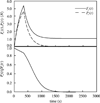A Conewise Linear Elasticity mixture model for the analysis of tension-compression nonlinearity in articular cartilage
- PMID: 11192377
- PMCID: PMC2854000
- DOI: 10.1115/1.1324669
A Conewise Linear Elasticity mixture model for the analysis of tension-compression nonlinearity in articular cartilage
Abstract
A biphasic mixture model is developed that can account for the observed tension-compression nonlinearity of cartilage by employing the continuum-based Conewise Linear Elasticity (CLE) model of Curnier et al. (J. Elasticity, 37, 1-38, 1995) to describe the solid phase of the mixture. In this first investigation, the orthotropic octantwise linear elasticity model was reduced to the more specialized case of cubic symmetry, to reduce the number of elastic constants from twelve to four. Confined and unconfined compression stress-relaxation, and torsional shear testing were performed on each of nine bovine humeral head articular cartilage cylindrical plugs from 6 month old calves. Using the CLE model with cubic symmetry, the aggregate modulus in compression and axial permeability were obtained from confined compression (H-A = 0.64 +/- 0.22 MPa, k2 = 3.62 +/- 0.97 x 10(-16) m4/N.s, r2 = 0.95 +/- 0.03), the tensile modulus, compressive Poisson ratio, and radial permeability were obtained from unconfined compression (E+Y = 12.75 +/- 1.56 MPa, v- = 0.03 +/- 0.01, kr = 6.06 +/- 2.10 x 10(-16) m4/N.s, r2 = 0.99 +/- 0.00), and the shear modulus was obtained from torsional shear (mu = 0.17 +/- 0.06 MPa). The model was also employed to predict the interstitial fluid pressure successfully at the center of the cartilage plug in unconfined compression (r2 = 0.98 +/- 0.01). The results of this study demonstrate that the integration of the CLE model with the biphasic mixture theory can provide a model of cartilage that can successfully curve-fit three distinct testing configurations while producing material parameters consistent with previous reports in the literature.
Figures






References
-
- Kempson GE, Freeman MA, Swanson SA. Tensile properties of articular cartilage. Nature. 1968;220:1127–1128. - PubMed
-
- Woo SL, Lubock P, Gomez MA, Jemmott GF, Kuei SC, Akeson WH. Large deformation nonhomogeneous and directional properties of articular cartilage in uniaxial tension. J Biomech. 1979;12:437–446. - PubMed
-
- Roth V, Mow VC. The intrinsic tensile behavior of the matrix of bovine articular cartilage and its variation with age. J Bone Joint Surg. 1980;62A:1102–1117. - PubMed
-
- Akizuki S, Mow VC, Muller F, Pita JC, Howell DS. Tensile properties of human knee joint cartilage. II. Correlations between weight bearing and tissue pathology and the kinetics of swelling. J Orthop Res. 1987;5:173–186. - PubMed
-
- Jurvelin JS, Buschmann MD, Hunziker EB. Mechanical anisotropy of human knee articular cartilage in compression. Trans Orthop Res Soc. 1996;21:7. - PubMed
Publication types
MeSH terms
Grants and funding
LinkOut - more resources
Full Text Sources
Other Literature Sources
Research Materials
Miscellaneous

